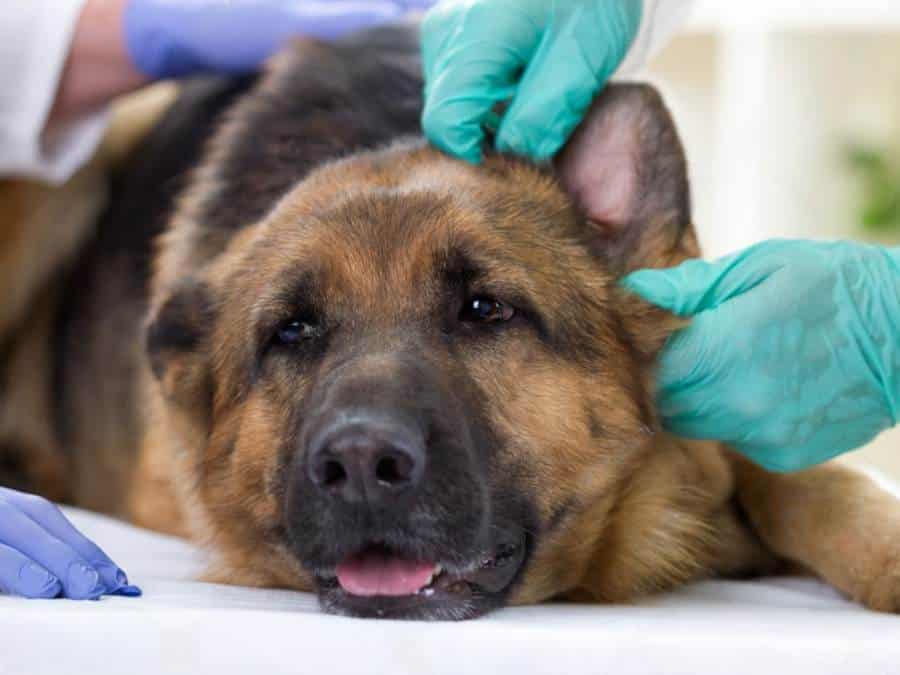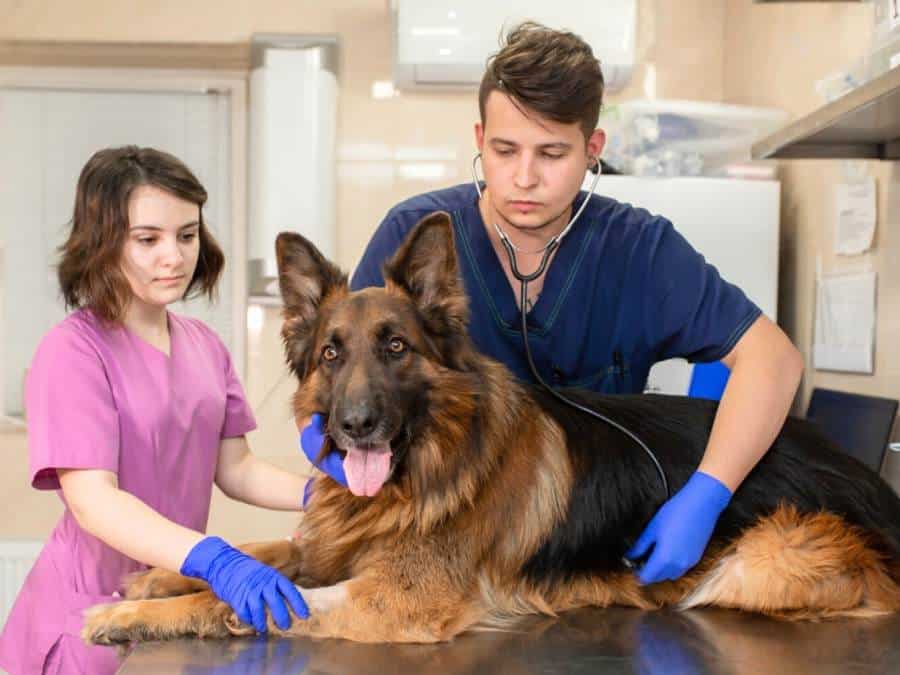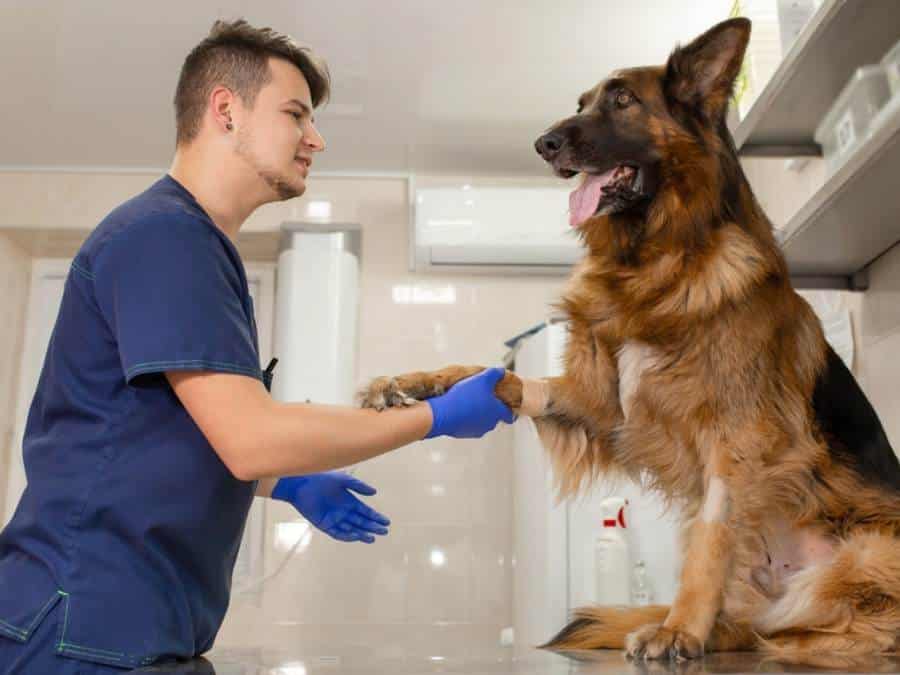German Shepherds, like other dog breeds, are susceptible to ear mite infestations. These minuscule creatures thrive in the warm and moist environment of the ear canal, making it an ideal breeding ground for them.
Once they take up residence in your dog’s ears, they can cause itching and inflammation.
As responsible German Shepherd owners, it’s essential to understand the causes, symptoms, and treatment options for this pesky condition.
So, in this article, we’ll dive into everything you need to know about German Shepherd ear mites.
What are Ear Mites?
Ear mites are tiny parasites that infest a dog’s ears, causing discomfort and irritation. These minuscule creatures, known as Otodectes cynotis, make their homes in the ear canals of dogs and survive by feeding on the wax and oils present there.
The Latin name of the bug means “ear beggar of the dog.” It belongs to the same family as spiders and ticks, making it an arachnid.
They usually stay within the ear but can also travel all over your dog’s body.

What do ear mites look like?
Ear mites are only 1-2 millimeters in length, so they are barely visible to the naked eye. They are incredibly small but they can sometimes be spotted as tiny specks that move around. When viewed under a microscope, these mites resemble minuscule spiders or ticks.
How quickly do they reproduce?
Ear mites in German Shepherds can quickly multiply, leading to a worsening infestation. These tiny creatures lay eggs on your dog’s skin, and within just 4 days, the eggs hatch. In a short span of 3 weeks, these young mites mature into adults. The adult mites have a lifespan of approximately 2 months.
Are ear mites contagious?
These pesky critters are highly contagious and can easily spread from one dog to another through close contact or sharing bedding, toys, or grooming tools. They can also be transmitted from other animals such as cats or rabbits.
According to the Cornell University College of Veterinary Medicine, the primary source of transmission for ear mites is direct contact with an infected animal. When dogs interact closely with each other, the mites can crawl from one host to another.
Ear mites also spread through self-infestation. When dogs scratch their itchy ears, they may unintentionally transfer mites to their paws or fur, which can then be spread to other body parts or surfaces, potentially causing reinfestation.
RELATED:

Symptoms of Ear Mites in German Shepherds
It’s crucial to keep an eye out for any signs of ear mite infestation in your German Shepherd. These pesky critters can cause serious discomfort and irritation for your furry friend.
Let’s dive into how you can recognize the symptoms of ear mites in your pup.
- Ear Scratching: Dogs with ear mites often scratch at their ears excessively. They may use their paws to scratch or rub their ears against furniture or the floor.
- Head Shaking: According to PetMD, Dogs may shake their heads frequently as a response to the discomfort caused by the mites.
- Ear Discharge: A dark, waxy debris resembling coffee grounds may be present in the ears. This discharge is a combination of mites, their waste, and ear wax.
- Wounds, inflammation, and infections: When a German Shepherd has ear mites, they tend to scratch their ears vigorously. This can cause cuts and infections to occur in the ear. One common sign of a mite infestation is a scab or abrasion found at the base of the ear. The dog’s hind limb claws are responsible for these scratches. If left untreated, these open wounds can become infected with bacteria, leading to further complications such as scabies.
- Foul Odor: Infected ears can produce a foul odor.
- Hair Loss: In severe cases, mites can cause hair loss around the ears and head due to the constant scratching.
- Irritability: Dogs with ear mites may become irritable or show signs of discomfort when their ears are touched.
It’s important to note that the symptoms of ear mites can be similar to other ear conditions, such as bacterial or yeast infections.
Therefore, it’s essential to have your German Shepherd examined by a veterinarian for an accurate diagnosis. They will be able to perform a thorough examination and may even use an otoscope to visualize the mites or their eggs.
If your German Shepherd is diagnosed with ear mites, don’t worry! This condition is treatable with proper medication prescribed by your veterinarian.
RELATED: How To Treat German Shepherd Yeast Infection
What should you do if you suspect your GSD has ear mites?
It’s better to go see your vet for an accurate diagnosis and treatment instead of relying on the over-the-counter medications or home remedies you find online. Other ear problems, such as bacterial or yeast infections, can have similar symptoms, and the treatment may vary.
If the veterinarian confirms an ear mite infestation, they will recommend an appropriate treatment plan. This may include cleaning the ears and administering medication.
Follow their instructions carefully, and complete the full course of treatment even if the symptoms improve before it’s finished.

How to diagnose ear mites in German Shepherds?
When your German Shepherd is experiencing discomfort in their ears, it’s important to seek veterinary assistance. A veterinarian will use several methods to diagnose ear mites in dogs.
These methods are aimed at examining the ears and identifying the presence of mites or related signs of infestation.
Here’s what you can expect during a veterinary examination for ear mites:
1. Physical Examination
The veterinarian will start with a general physical examination of your dog. They may observe your dog’s behavior, look for signs of discomfort, and check for visible symptoms such as scratching, head shaking, and redness around the ears.
2. Otoscopy
The vet will use an otoscope, a specialized instrument with a light, to examine the inside of the ear canal.
This allows them to visualize the ear canal and the eardrum. If ear mites are present, they may be visible with the otoscope.
3. Ear Swab or Ear Cytology
The vet may take a swab from the ear canal to collect a sample of ear discharge. This sample can be examined under a microscope in a process called ear cytology.
Ear mites, their eggs, or other debris associated with mite infestations can be identified during this examination.
4. Identification of Mites
Under the microscope, the veterinarian can identify the presence of ear mites or their characteristic appearance, helping confirm the diagnosis.
5. Clinical Signs and History
The vet will consider the overall clinical signs observed, your dog’s history, and any information you provide about your dog’s behavior and symptoms.
Once the diagnosis is confirmed, the veterinarian will discuss a treatment plan with you. Treatment often involves cleaning the ears to remove debris and administering medication to eliminate the mites.
Depending on the severity of the infestation, the vet may prescribe topical or systemic medications.
RELATED: How To Treat German Shepherd Ear Infection

German Shepherd Ear Mites Treatment
The treatment of ear mites in German Shepherds typically involves a combination of cleaning the ears to remove debris and administering medications to eliminate the mites.
Here is an overview of the common steps involved in treating ear mites:
1. Ear Cleaning
The veterinarian will often start by cleaning the dog’s ears to remove wax, debris, and mite populations.
This may be done using a gentle ear-cleaning solution. The vet may demonstrate the proper technique for cleaning your dog’s ears at home.
2. Medication
Medications are prescribed to kill the ear mites. The type of medication can vary, and it may be administered in different forms:
- Topical Medications: These are applied directly to the skin of the ear. This can include ear drops or ointments. It’s essential to follow the veterinarian’s instructions on how to apply these medications.
- Systemic Medications: In some cases, oral medications may be prescribed. These medications circulate throughout the dog’s body and are effective against mites.
3. Follow-Up Treatments
The veterinarian may recommend a follow-up appointment to assess the progress of the treatment. Additional treatments may be necessary, depending on the severity of the infestation.
4. Environmental Cleaning
Since ear mites are highly contagious, it’s important to clean the dog’s environment. Wash your dog’s bedding and clean areas where your dog spends time to prevent reinfestation.
5. Treatment of Other Pets
If you have other pets, especially those in close contact with the affected dog, the veterinarian may recommend checking and treating them for ear mites as well.
It’s crucial to complete the full course of treatment as prescribed by the veterinarian, even if the symptoms improve before it’s finished. Failure to do so may result in the reinfestation of mites.

When can I expect my GSD to fully recover from ear mites?
Most dogs recover fairly quickly from ear mites, but some may continue to struggle with these annoying pests. Your veterinarian might suggest a follow-up checkup to ensure that your dog’s ears have returned to normal. If they haven’t, the vet will provide further treatments. In some cases, there may be leftover debris in your dog’s ear canal that needs to be flushed out. If there is also a bacterial or yeast infection present, your vet may need to prescribe additional or different medication to treat the infection.
How did my German Shepherd get Ear Mites?
Ear mites, scientifically known as Otodectes cynotis, are highly contagious and can easily spread from one animal to another. If you’re wondering how your German Shepherd got ear mites, here are some possible reasons:`
1. Contact with Infected Animals: Ear mites can be transmitted through direct contact with other animals that are already infested. This can happen during interactions with other dogs at parks, kennels, or even in your own backyard.
2. Shared Living Spaces: If your German Shepherd shares living spaces with other animals, such as cats or other dogs, there is a higher risk of ear mite transmission.
These mites can survive in the environment for several weeks, so if an infested animal has been in the area, your dog may become infected.
3. Grooming Tools and Accessories: Sharing grooming tools, such as brushes or ear cleaning solutions, between animals can also lead to the spread of ear mites.
If an infested animal has used these tools before your German Shepherd, they can transfer the mites onto your dog.
4. Stray or Feral Animals: If your German Shepherd has had contact with stray or feral animals, they may have been exposed to ear mites.
Strays are more likely to carry parasites due to their living conditions and lack of regular veterinary care.
5. Mother-to-Puppy Transmission: If your German Shepherd comes from a breeding environment where proper hygiene and parasite prevention measures are not followed, they may have acquired ear mites from their littermates or parents.
6. Pet Grooming Facilities: Dogs that frequent pet grooming facilities, boarding kennels, or other places where they come into contact with different animals may be exposed to ear mites.
It’s important to note that ear mites are species-specific, meaning they are adapted to infest specific types of animals. While ear mites in dogs are caused by Otodectes cynotis, other types of mites can infest other animals, such as cats or rabbits.

How to Prevent Ear Mites in German Shepherds?
Fortunately, there are steps you can take to prevent ear mites and keep your German Shepherd’s ears clean and healthy.
Here’s a guide on how to prevent ear mites in German Shepherds:
- Regular ear cleaning: Clean your German Shepherd’s ears regularly to remove dirt, debris, and wax buildup. Make sure that you use a veterinarian-recommended ear-cleaning solution.
- Check for signs of infection: Keep an eye out for any signs of ear infection, such as redness, swelling, discharge, or a foul odor. If you notice any of these symptoms, consult your veterinarian for proper diagnosis and treatment.
- Avoid excessive moisture: After bathing or swimming, make sure to thoroughly dry your German Shepherd’s ears to prevent moisture buildup.
- Treat and prevent fleas: Ear mites can be transmitted from pet to pet, and they are often associated with flea infestations. Use appropriate flea prevention methods to reduce the risk of ear mite transmission.
- Avoid contact with infected animals: Limit your German Shepherd’s contact with other animals known to have ear mites to reduce the risk of transmission.
- Keep your home clean: Regularly clean your home, especially your German Shepherd’s bedding and favorite resting areas. Vacuuming and washing bedding in hot water can help eliminate any potential mites or eggs.
- Maintain a healthy immune system: Provide your German Shepherd with a balanced diet, regular exercise, and routine veterinary care to keep their immune system in top shape.
By following these preventive measures, you can significantly reduce the risk of ear mites in your German Shepherd. Remember, early detection and prompt treatment are crucial in managing any potential ear mite infestations.
Conclusion
In conclusion, ear mites can be a pesky and uncomfortable problem for German Shepherds. By recognizing the symptoms and understanding their contagious nature, you can take proactive steps to protect your furry friend’s ear health. Remember that it’s important to consult a veterinarian for proper diagnosis and treatment. Prevention techniques such as regular cleaning and routine check-ups can also go a long way in keeping ear mites at bay.
FAQs
1. Can German Shepherds get ear mites?
Yes, German Shepherds can get ear mites. These tiny parasites are common in dogs and can cause itching, irritation, and inflammation in the ears. It’s important to seek veterinary treatment to effectively eliminate the mites and alleviate your dog’s discomfort.
2. How do I know if my German Shepherd has ear mites?
If your German Shepherd is constantly scratching or shaking their head, it may be a sign of ear mites. You might also notice redness, discharge, or a foul odor coming from their ears. A veterinarian can perform an examination and confirm the presence of ear mites.
3. How are ear mites in German Shepherds treated?
Treatment for ear mites in German Shepherds typically involves cleaning the ears and administering medication prescribed by a veterinarian. This may include topical ointments or oral medications to kill the mites and soothe any inflammation.
4. Can I treat my German Shepherd’s ear mites at home?
While there are some over-the-counter products available for treating ear mites, it is always recommended to consult with a veterinarian before attempting any home remedies. They will provide you with safe and effective treatment options tailored to your German Shepherd’s specific needs.
Also read:




